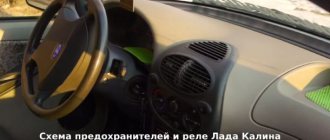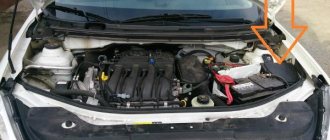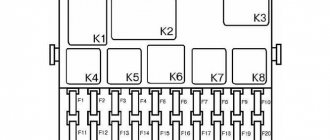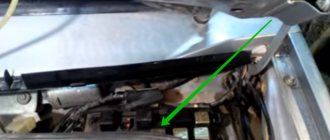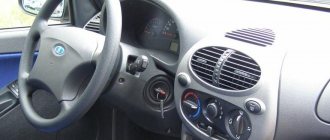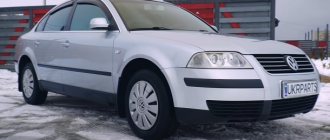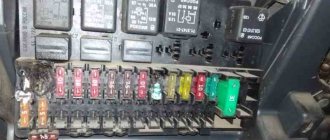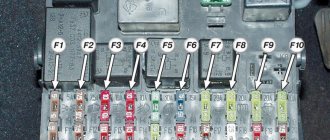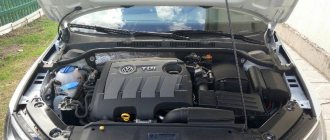Daewoo Lanos was introduced in 1997. With various modifications and changes, it was produced in 1998, 1999, 2000, 2001, 2002, 2003, 2004, 2005, 2006, 2007, 2008, 2009, 2010, 2011, 2012, 2013, 2014, 2015 and 2016 and delivered to various regions world with sedan and hatchback bodies. Also known as ZAZ Lanos, Daewoo Sens, Chevrolet Lanos. In this publication you will find a description of fuse and relay blocks of Daewoo Lanos with block diagrams and photographs of the design. Let's highlight the cigarette lighter fuse.
The purpose of fuses and relays may differ and depend on the year of manufacture and country of delivery of Lanos.
Working principle of a car fuse
The components of automotive fuses are elements such as a body and a fuse link. Chevrolet and Daewoo Lanos vehicles are equipped with flag or plug-type devices. The body of such devices is made of plastic. The fuse link is located inside the housing, which does not necessarily have to be sealed. Two contacts (legs) protrude from the body, through which the part is installed in the electrical circuit of a certain device.
The most important parameter of a fuse is the amount of current it is designed for. All devices are designed to protect electrical wiring from fire, as well as prevent failure of electrical appliances. In simple terms, a fuse protects electrical equipment from short circuits and the flow of high current. High current can lead to melting and subsequent spontaneous combustion of the wiring.
The fuse link of the element is designed for a certain amount of current, which depends on the power of the pantograph (electrical equipment). As soon as the current in the circuit exceeds the rated value for which the fuse is designed, the fuse-link burns out. As a result, the circuit opens, thereby preventing melting of the wire insulation and failure of electrical appliances.
Once a fuse has tripped, it cannot be repaired and must be replaced with a similar current rating. It should be installed in place of the failed element only after the cause of the device’s operation has been identified. If, when replacing a failed fuse, you install a device with a lower or higher current strength, this will lead to the following situations:
- If the current is below the rated current, the device will trip when electrical appliances are turned on
- If the current is higher than the rated current, the fuse will not work, which will lead to melting of the insulation, as well as failure of the electrical appliance.
The rating of the protective element is indicated on the front side of the product. Additionally, manufacturers produce devices that vary in color. The color corresponds to the current strength for which the protective device is designed. Below is a table showing the device rating depending on color.
Using a table with colors is very convenient when the fuse rating is not visible. If you don’t know what rating a protective element should have in a circuit with a particular electrical appliance, then you shouldn’t guess. You can calculate it or use the information provided below.
There is no voltage supplied to the fuel pump
The fuel pump on Lanos, especially the original one, is not a cheap part, so before condemning it, you need to check the power circuits going to it. So, guess one: the pump is alive and well, the problem is in the power supply. Let's consider the classic sequence of checking the fuel pump for an open circuit.
Checking the fuel pump fuse - useful advice
Let's start with where the fuel pump fuse EF16 and relay K9 are located, which switches the power circuit from the battery to the fuel pump.
Now I will tell you one piece of advice that applies to all fuses in general, and which can save a lot of nerves and money in the future. And here's my advice - don't believe your eyes! If you have a spare fuse, then it is better to install it, and here's why: it happens that the fuse does not burn out , but simply cracks when you take out the fuse - visually it is intact and even rings, but when you insert it back, the legs move apart sides and contact disappears! If you have a multimeter, then you can ring the fuse without removing it from the block: on the sides of the fuse there is access to the terminals. My next piece of advice is to pay attention to the terminals and the plastic around them - poor contact may be between the terminal and the fuse leg. In my case, the fuse turned out to be intact, the next step is to check the fuel pump relay.
How to check the fuel pump relay
What can happen to the relay in principle, due to which it will stop switching the power circuit (from the battery): the contacts inside the relay may burn due to sparking, secondly: poor contact between the terminals and legs of the relay and the third thing that will need to be checked – voltage level on the control circuit (voltage that causes the relay contacts to attract). The picture above shows the principle of operation of the relay, the picture below shows the relay contact numbers and the electrical diagram.
The easiest way is to find the same relay in the relay block, for example, the radiator fan switching relay and swap it, while first inspecting the relay legs and terminals for carbon deposits, and also checking whether the seats for the terminals have melted. After you swap the relay, of course, you will need to check whether the fuel pump is working by turning the key in the ignition. If the result is negative, you need to measure the control voltage with a multimeter: remove the fuel pump relay, turn the ignition key and check the voltage between terminals 85 and 86. Automotive relays of this type operate at a voltage value of 7 V or more.
If you don’t have a multimeter, you can do it simpler: insert a jumper between power terminals 30 and 87, thereby eliminating the presence of a relay in principle. After this, sit in the passenger compartment and turn the key in the ignition. In my case, the fuel pump did not work.. Then I proceeded to the second stage of testing - to the fuel pump itself.
Where are the fuses on Chevrolet and Daewoo Lanos?
One of the main questions that all car owners ask is where the fuses are located. Before diagnosing the power circuit of a particular non-working electrical appliance, you should first find the required fuse. There are three places on Lanos where these devices are located. We will find out more about their location below.
Lanos have three fuse and relay blocks. Their locations are not known to all car owners, so we present information with photos:
- Block in the engine compartment. If you remove the cover of the unit, you will find the presence of not only protective devices, but also relays. This block is the main one, since this is where the devices responsible for protecting the ignition switch circuit are located
- Block in the cabin near the driver's feet. This block contains only fuses without relays. This block contains protective devices included in the circuit of interior electrical appliances - interior lighting, hazard warning lights, radio, ECU power supply, dimensions, etc.
- Relay box under the instrument panel. To gain access to it, you need to remove the decorative plug on the side of the dashboard or remove the panel of the headlight electric corrector unit. This unit is equipped with relay only
- An additional fuse is installed on the right side near the passenger's feet. It should be noted that this element was not installed on all Lanos cars, but only on those with an ABS anti-lock braking system. Its rating is 10A
- Additional relays are also installed under the hood of the car on the left side near the engine compartment
Knowing where the fuse and relay blocks are located on Chevrolet and Daewoo Lanos, you need to figure out which electrical appliances they are responsible for protecting and operating.
Checking the fuel pump directly
Having suffered a fair amount, it’s time to suffer even more... To gain access to the fuel pump cover, you need to “pull” the rear sofa: it is attached in two places to the floor (seen in the photo above), approximately in those places you need to pull. We removed the sofa - we unscrew the cover with a screwdriver and see the fuel pump connector (in the photo above on the right). To check the fuel pump directly , excluding all other elements of the car's electrical wiring, you need to apply voltage to the fuel pump directly from the battery. To do this, you first need to find which contacts in connector C901 are responsible for powering the fuel pump.
The picture above shows a connector (or, as people say, a chip) of a fuel pump (view from the pins). I didn’t remove the fuel pump from the gas tank, I just used a long wire to connect it to the battery. The fuel pump turned out to be alive!
Having experienced some bewilderment in connection with the diagnostic information received ( the pump is working, the fuse is working, the relay is working - all the obvious participants in the circuit are working! ), I decided to use a tester to check the voltage on the second half of the fuel pump connector (C901), coming from the bowels of the car. There was tension on him! That is, voltage was supplied to the fuel pump, the fuel pump was working, but did not work! How is this possible, you ask?
Fuse and relay box under the hood on Lanos
This block is located on the right side when you open the hood. It is closed with a plastic lid, which ensures tightness. The lid is secured with latches. Under it there are not only fuses, but also relays. For easy removal of fuses, there is a special plug. Below in the photo is the digital designation of devices, the decoding of which is in the table.
Fuse element F1 protects the power supply circuit of fuses F1-F7 and F15-F20. F12 - used on cars with air conditioning. Protects the electrical clutch circuit of the air conditioner. F15 is an air conditioning compressor clutch relay diode. F19 - protects the power supply circuit of the brake light, electric headlight adjustment, exterior lighting on the left side, corrector illumination, clock, rear fog lights, ashtray lamp, radio and air conditioner illumination. F20 - additionally protects the power supply circuit for the right headlight and license plate lights.
In the table above, relay R3 is used on Lanos cars with air conditioning. This relay is responsible for the operation of the electrical clutch of the air conditioning compressor. R4 - this element may also not be used if there is one fan on Lanos, Sens or Chance. He is responsible for turning it on. R5 - turns on the front fog lights if the car has them. R11 - relay for turning on the cooling fans at first and second speed.
Fuse box in the car interior on the left under the trim
The interior fuse box of Lanos, Sens and Chance is responsible for protecting various electrical equipment. There are 20 fuses located on this block in the passenger compartment. Let's look at their purpose in detail.
The table below provides not only a description of the purpose of each element, but also the maximum current value. When searching for or replacing cabin fuses on a Lanos, you must rely on the data from the table.
Fuse F2 is responsible for turning off the rear PTF lamps. It also protects the power supply circuit for the headlight range control and the door open alarm. F5 - protects the power supply circuit of the vehicle's ECU. The power cable comes directly from the battery. Fuse F8 on the block is responsible for supplying power to the light alarm on the driver's door. Element F13 is responsible for the proper operation of the airbags. F15 - supply voltage to the coil or ignition module. F20 - battery for the electric heater motor for speeds 1-3.
Relay block under the torpedo Lanos, Sens and Chance
Behind the control panel for the headlight range control of Lanos, Sens and Chance cars there are four relays responsible for the operation of the rear fog lights, direction indicators and hazard lights, heater fan and windshield wipers.
Under number “1” in the photo above there is a relay that is responsible for the operation of the electric heater motor, which is turned on at 4 speeds. If the stove stops working in position 4, then you need to check the serviceability of the relay. Number “2” is the device responsible for the operation of the car’s turn relay and hazard warning lights. Number “3” is the relay responsible for the operation of the windshield wiper, which operates in intermittent mode. Number “4” is the rear fog lamp relay on Lanos, Sense and Chance.
Separately, it should be noted that under the hood there are two more or one relay, which depends on the year of manufacture of the car. The devices are located on the left when the hood is opened near the engine shield. One element is responsible for sending a signal to start the engine, and the second is intended to control the operation of the generator. The relay supplies power to the generator integrated board.
This is interesting!
Short-circuiting relay contacts directly without using the device is strictly contraindicated. This will not only lead to the fuse tripping, but also the failure of electrical appliances.
DIY cigarette lighter lighting in Lanos
The dimensions of the Chevrolet Lanos are convenient for carrying out all actions. The cigarette lighter has a characteristic blue fuse, designated F10 15A.
Chevrolet forum. Forum for Chevrolet lovers and owners. Nizhny Novgorod forums. The cigarette lighter stopped working. I can not…
I enjoy driving at night on city streets.
Fuse failure. Location of the fuse box in the passenger compartment. Another reason why the cigarette lighter does not work is damage to fuse F
They are located under the hood to the left of the battery.
ZAZ Chance, Chevrolet Lanos air conditioning does not work, fuse keeps blowing
Most fuses are located inside the car and are located on the front of the body under a special cover. The Chevrolet Lanos cigarette lighter fuse is different from all the others.
Replacing the cigarette lighter with a new one
Each fuse is equipped with certain functions and features for recognition. The cigarette lighter has a characteristic blue fuse, designated F10 15A. If it burns out, it is clear what needs to be replaced with what.
Replacement is carried out quite quickly if the necessary fuse is available. There are diagrams of the location of all car fuses. They make it easy to recognize where the cigarette lighter fuse is located on a Chevrolet Lanos.
Chevrolet Lanos cigarette lighter does not work: what to do?
The difference is the absence of a corresponding light indicator. I enjoy driving at night on city streets. I try to do my own repairs on my cars!
Basic malfunctions Check that the cigarette lighter is securely in the socket. The main problem with the cigarette lighter is that it does not fit well into the socket.
This happens because the plates that hold the heating element are slightly bent.
To correct this situation, you can slightly straighten the plates. This can be done using a regular screwdriver.
Fuse failure. Location of the fuse box in the passenger compartment. Another reason why the cigarette lighter does not work is damage to fuse F. This part is located in the mounting block near the driver’s feet. This fuse is intended only for the cigarette lighter, and therefore, if it blows, then only the cigarette lighter will not work.
The fuse may blow due to the fact that a strong electrical consumer is inserted into the socket. In this case, it is worth changing the fuse, finding it according to the diagram. Cigarette lighter failure External inspection. If after replacing the fuse it does not work, check the voltage at the cigarette lighter terminals.
What is a relay and its purpose on a car
An element such as a relay on a Lanos, Sense and Chance car is designed to close and open electrical circuits. In simple terms, these devices supply power to powerful electrical appliances through small buttons.
If you do not use a relay, and, for example, start the engine directly, then the contacts in the ignition switch will immediately burn out or the button will melt. This is due to the fact that when starting the engine, the starter consumes a very large current, which, when passing through the ignition switch contacts, would melt them.
To avoid making the on and off buttons massive, relays are used in cars. These are a kind of protective devices that divide the circuit into high-voltage and low-voltage. The devices have a simple design, and their main element is a coil with a winding. When using a relay, it is important to understand the purpose of its contacts:
- 85 and 86 - coil contacts
- 30 - common, which is supplied with constant power from the battery
- 87 - normally open contact or power supply to the receiver
- 87a - normally closed contact, which is also called additional
When replacing a relay, it is important to pay attention to which element was previously in the socket - three, four or five-pin. Replace only with a device of similar design.

